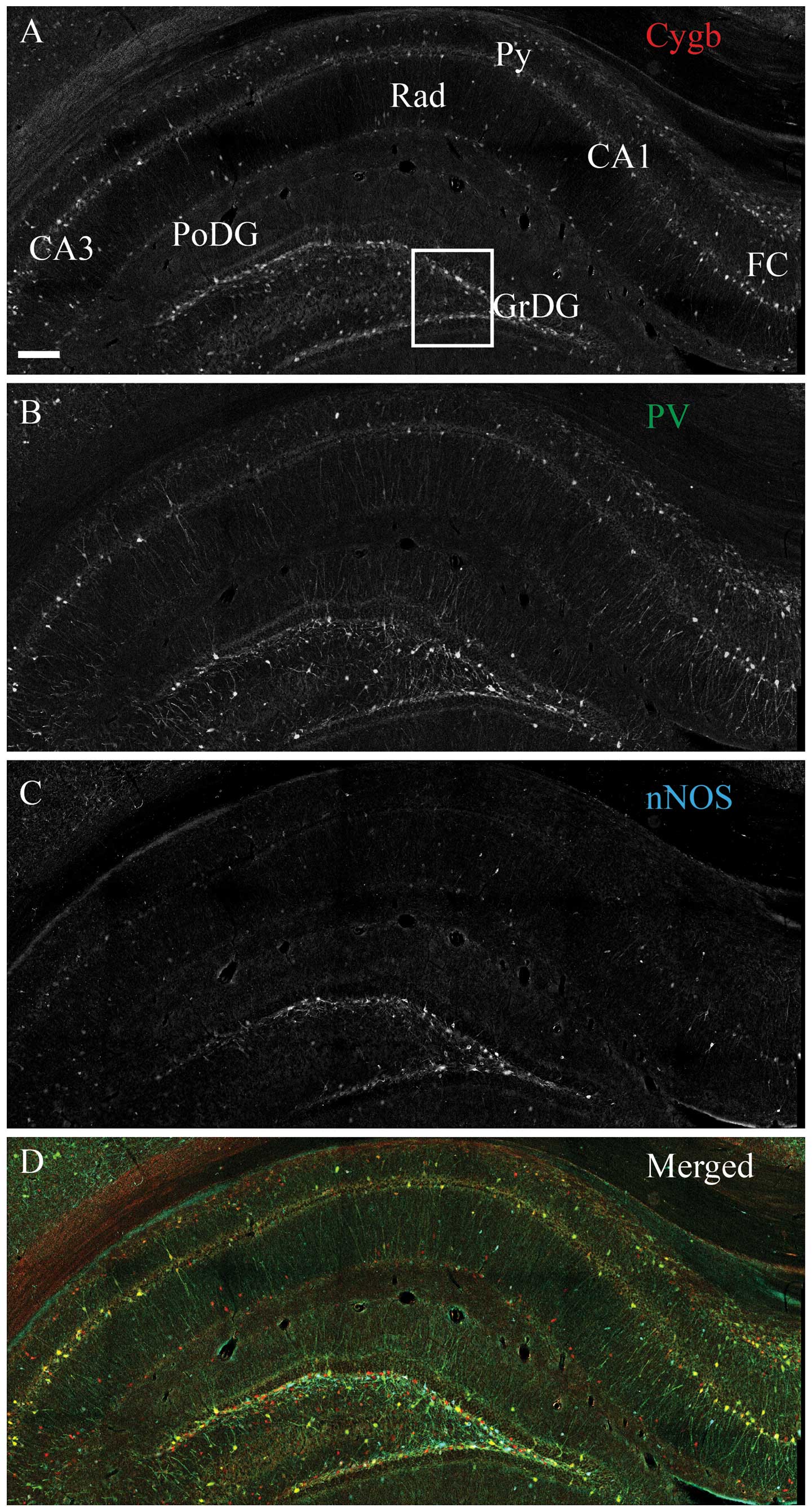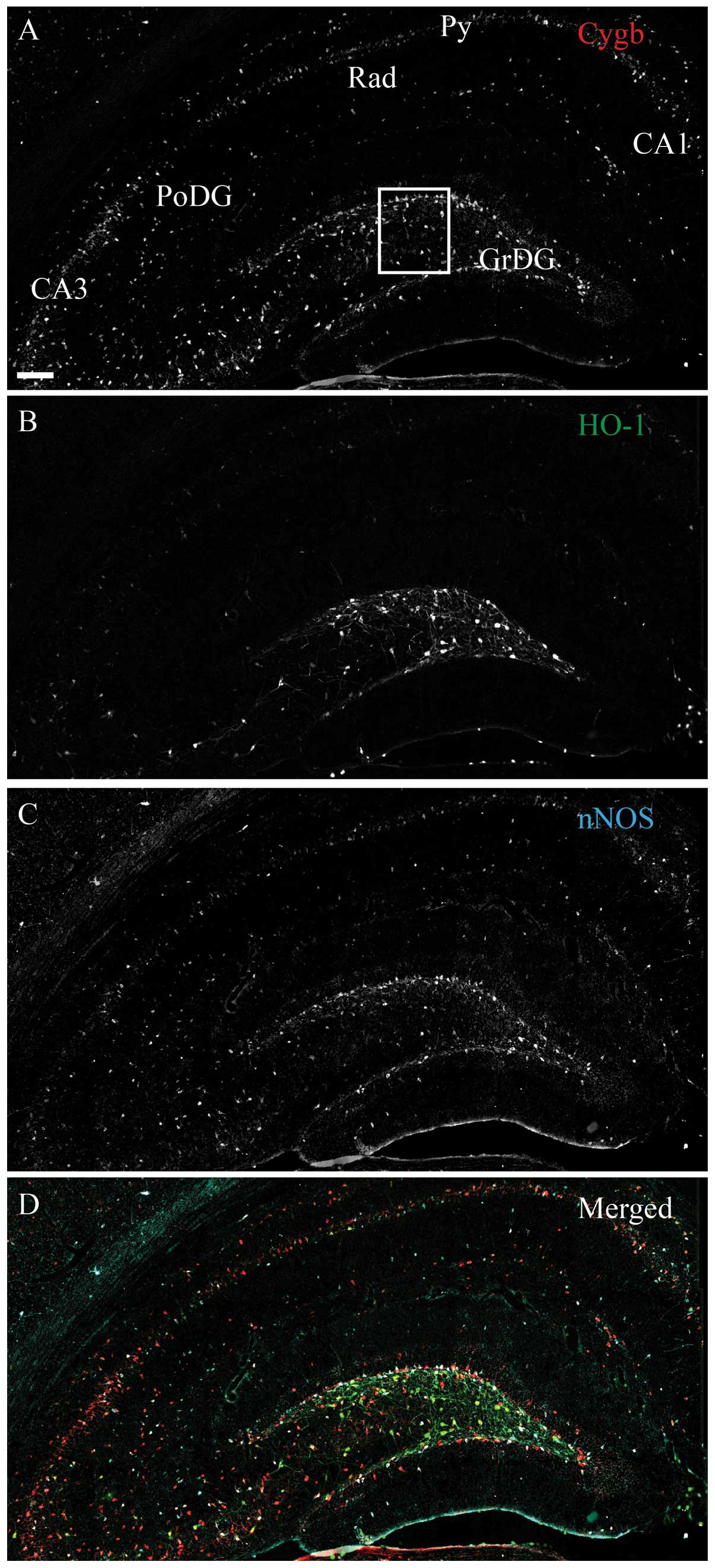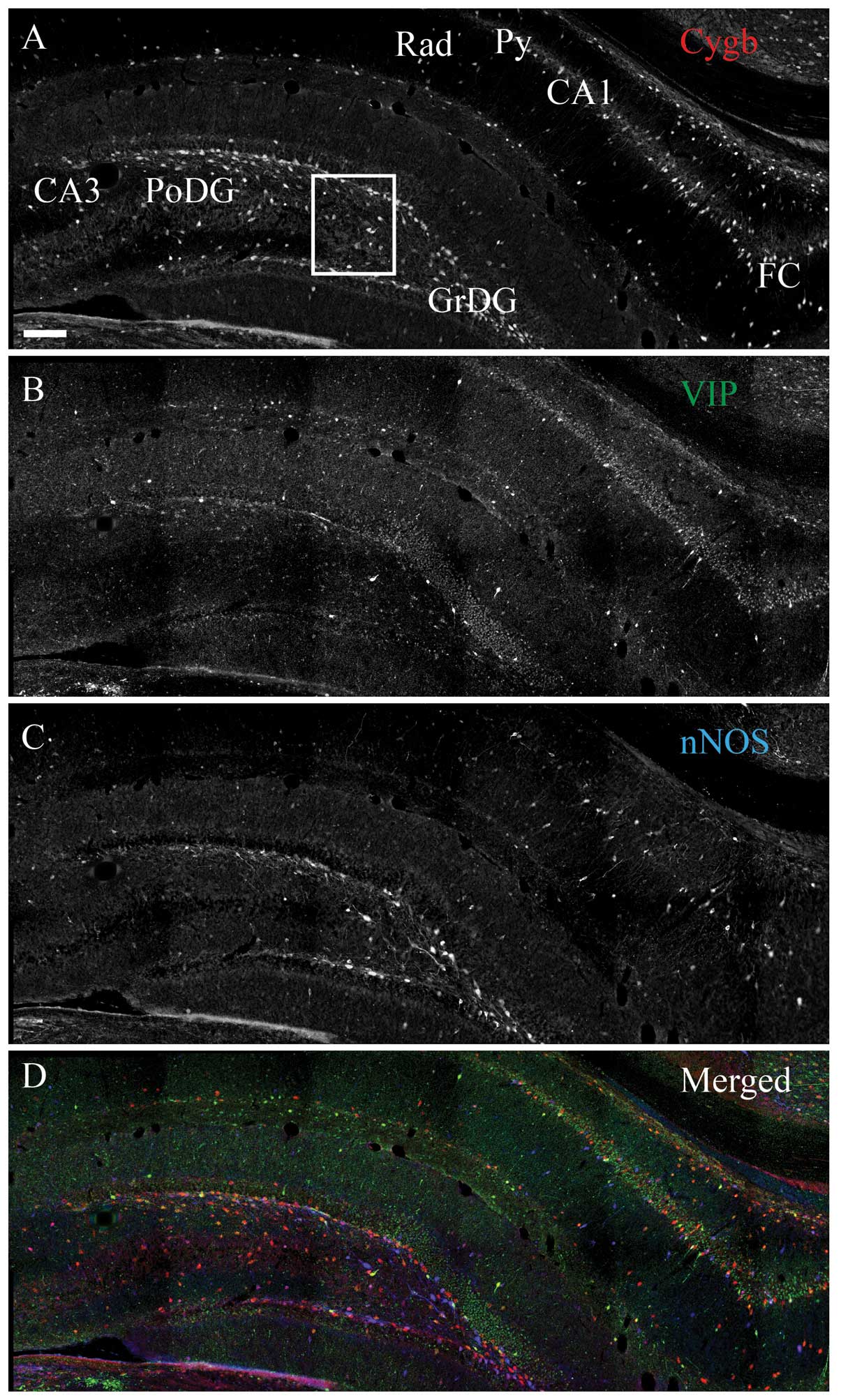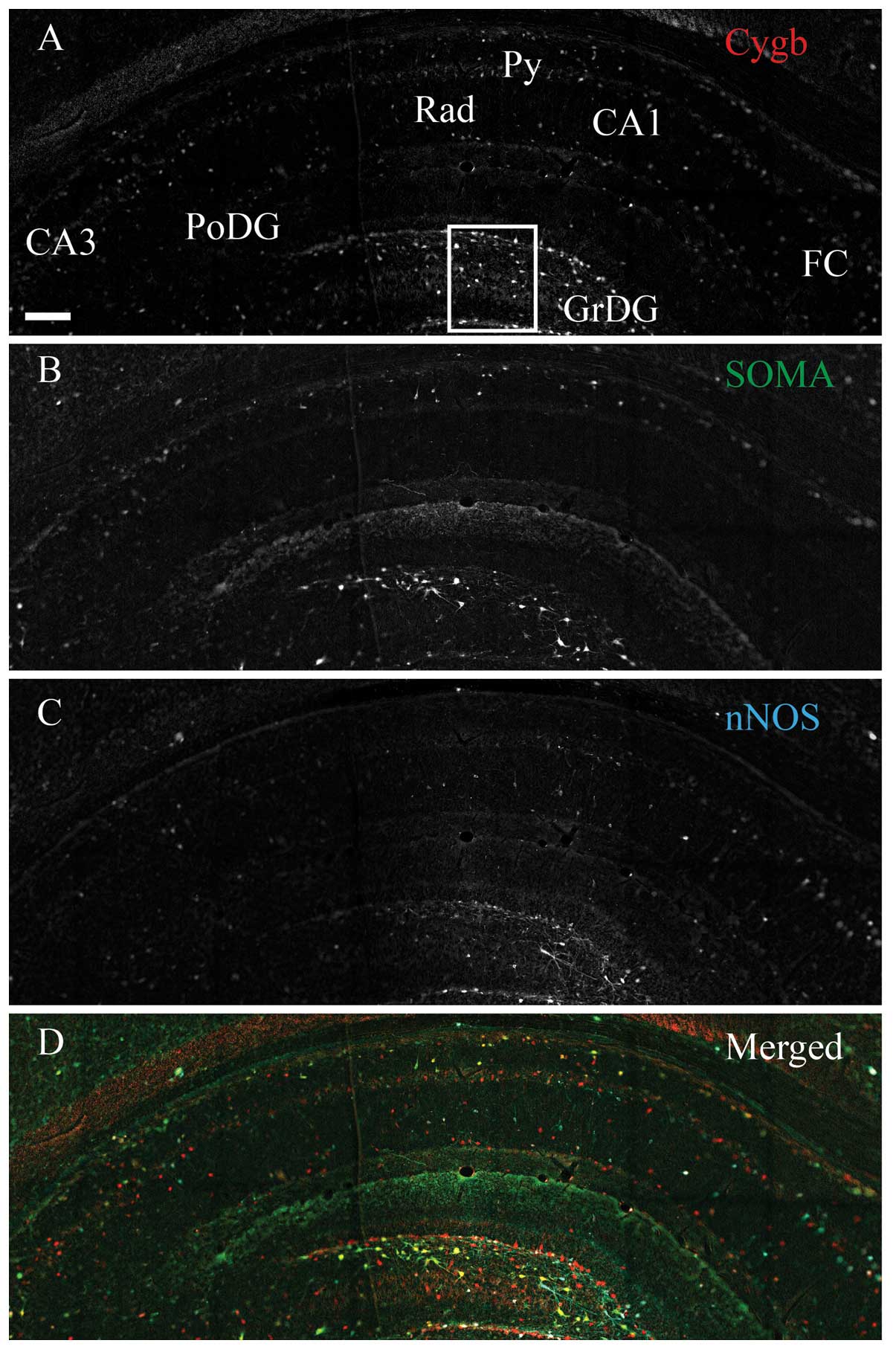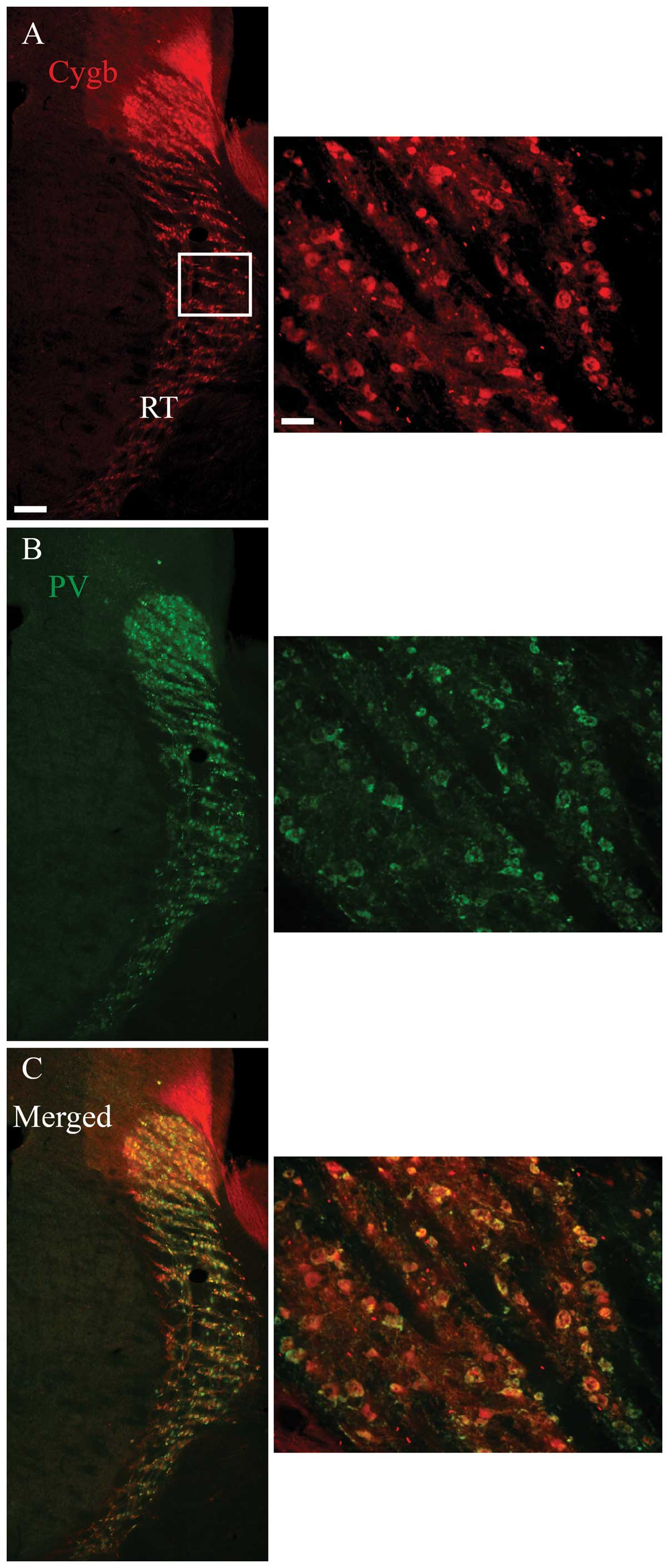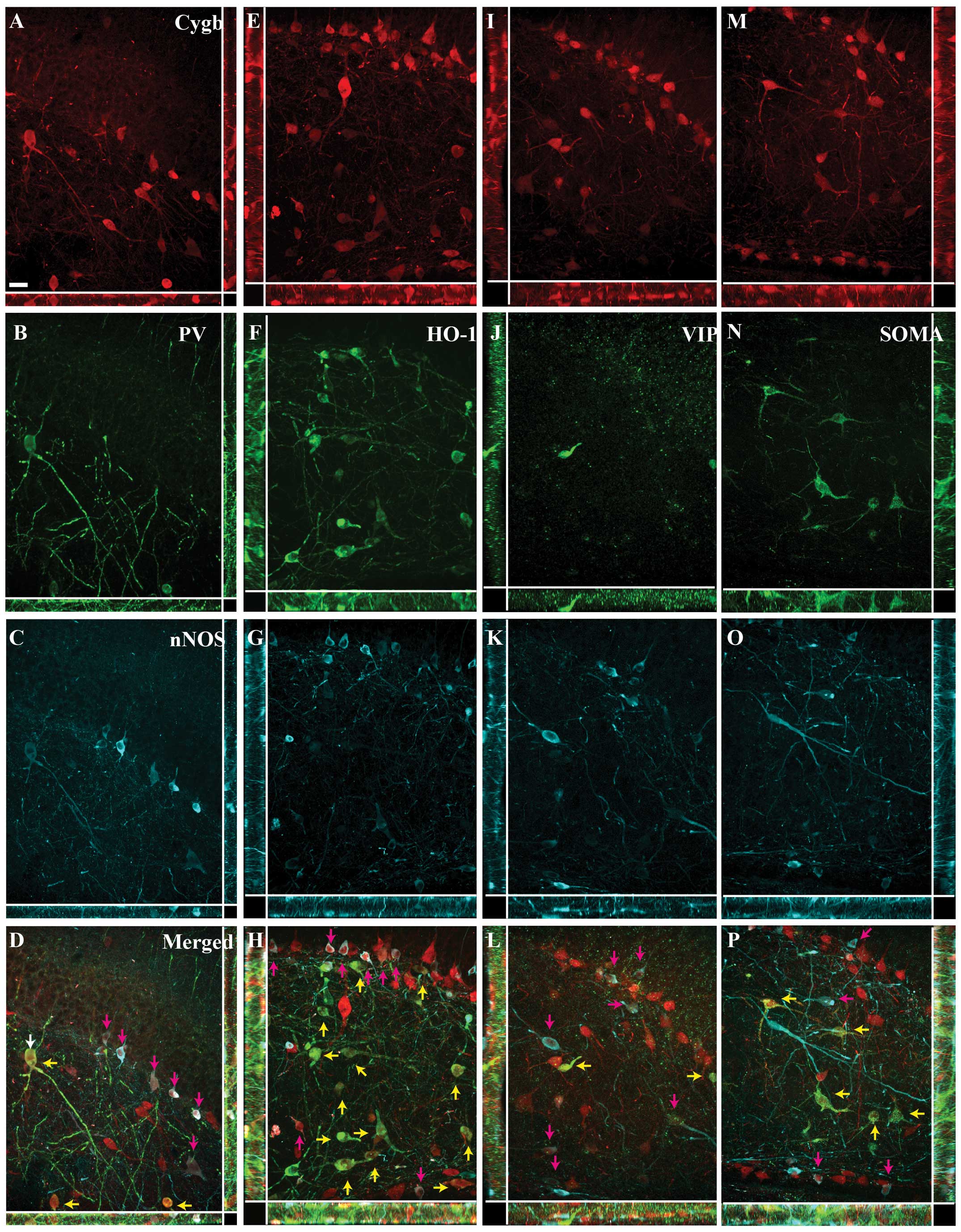Neurochemical phenotype of cytoglobin‑expressing neurons in the rat hippocampus
- Authors:
- Published online on: June 16, 2014 https://doi.org/10.3892/br.2014.299
- Pages: 620-627
Abstract
Introduction
The hippocampus is of paramount importance as it controls a wide range of physiological processes, including learning and memory, spatial navigation and neurological diseases, such as Alzheimers’s disease (AD), depression, schizophrenia and stroke, which often target the hippocampus and have profound effects on physiology (1–4). The function of the hippocampus has been extensively studied from a behavioral, biochemical and neuroanatomical perspective, establishing the hippocampus as an excellent model for studying the function of a protein. Cytoglobin (Cygb) was identified as the fourth vertebrate heme-globin in 2002 (5,6). Cygb has, despite low sequence homology with the canonical hemoglobin and myoglobin, retained the classical globin fold and can reversibly bind oxygen and other diatomic gasses (7). Cygb is expressed in a number of tissues and is also found in neurons of the brain where Cygb is localized in the soma, neuronal processes and nuclei (8,9). Within the mouse brain, Cygb is expressed in distinct areas with large regional differences in the expression levels. The areas with pronounced Cygb expression are the hippocampus, reticular thalamic nucleus (RT), habenula, laterodorsal tegmental nucleus and the pedunculopontine tegmental nucleus (8,10,11). The Cygb expression patterns in the mouse brain were recently determined to be identical in the rat and human brain, demonstrating that the rodent brain can be used as a translational model for studying Cygb in humans, at least at the anatomical level (12,13). The function of Cygb remains largely unknown, but several studies have linked Cygb to reactive oxygen/nitrogen species (RNS) nitric oxide (NO) scavenging (14–20). Furthermore, Cygb overexpression protects against ischemic cell death in vivo (21), although not when expressed at endogenous levels (22). In our previous studies, Cygb-immunoreactivity (ir) was shown to be highly co-localized with one of the enzymes producing NO, namely neuronal nitric oxide synthase (nNOS), in the mouse brain (9) and found that the majority of the nNOS-ir neurons of the rat hippocampus co-localized with Cygb-ir (13). However, due to the larger number of Cygb-ir cells in the hippocampus, the majority of Cygb-ir cells remain uncharacterized (13).
The aim of the present study was to extend our previous study (13) in the rat hippocampus by providing a detailed neurochemical phenotype of the Cygb-ir neurons in association with the subpopulation co-expressing nNOS. Knowledge regarding the neurochemical phenotypes of neurons expressing the protein of interest can be a valuable tool, as it will allow the investigator to determine if the protein of interest is primarily co-localized with one other protein or groups of proteins associated with known specific functions or pathways. This information can then be used to test functional hypotheses regarding the protein of interest by investigating whether affecting the functions/pathways of the co-expressing proteins will also affect the protein of interest.
Materials and methods
Animals
Six male Wistar rats (250 g) from Taconic (Denmark), were used in the experiment. All the rats were perfusion-fixed in 4% paraformaldehyde and the brains were dissected and post-fixed in the same fixative for 24 h at 4°C. The brains were cryo-protected with 30% sucrose in phosphate-buffered saline for five days and stored at −80°C until required. The brains were cryo-sectioned in 40-μm coronal sections in a series of five sections. Animal care and all the experimental procedures were conducted in accordance to the principles of Laboratory Animal Care (Law on Animal Experiments in Denmark, publication 1306, November 23, 2007) and approved by the Faculty of Health, University of Copenhagen (Copenhagen, Denmark).
Immunohistochemistry (IHC)
The IHC protocol has been described previously (23). The primary antibodies employed for IHC were: i) Rabbit anti-Cygb [in-house, code# 5092/6, 1:3,000 dilution and characterized previously (9,12,13)]; ii) sheep anti-nNOS [Dr Emson, University of Cambridge (Cambridge, UK), 1:3,000 dilution and characterized previously (24,25)]. nNOS produces the gas-neurotransmitter NO, which is involved in a number of physiological and pathological processes, including vasodilatation and RNS-mediated damage. iii) Goat anti-somastostatin (SOMA) [code# sc-7819, 1:1,000 dilution and characterized previously (26,27); Santa Cruz Biotechnology, Inc., Santa Cruz, CA, USA]. SOMA is a neuroendocrine peptide hormone and regulates a number of secondary hormones via its G protein-coupled receptors. iv) Rabbit anti-vasoactive intestinal peptide (VIP) [in-house, code# 291E-3, 1:15,000 dilution and characterized previously (28)]. VIP is a major regulatory peptide in the brain and is involved in a number of processes, including circadian and neuroendocrine control. v) Rabbit anti-parvalbumin (PV) [code# PV25, 1:40,000 dilution and characterized previously (29,30); Swant, Swizerland]. PV is a calcium-binding protein involved in numerous physiological processes. vi) Rabbit anti-heme oxygenase 1 (HO-1) [code# ADI-SPA-895, 1:60,000 dilution and characterized previously (10,31); Enzo Life Sciences, AH Diagnostics AS, Aarhus, Denmark]. HO-1 is an enzyme that catalyzes the degradation of heme groups to produce biliverdin, iron and the gas-neurotransmitter carbon monoxide. The primary antibodies were detected with either a donkey anti-sheep Alexa-488 or 568 (code# A11015 and A21009, 1:800 dilution; Life Technologies, Carlsbad, CA, USA), donkey anti-rabbit Alexa-594 or 647 (code# A21207 and A31573, 1:800 dilution; Life Technologies) and donkey anti-goat Alexa-649 (code# 705-606-147, 1:300 dilution; Jackson Immunoresearch Laboratories, Inc., West Grove, PA, USA). When two rabbit primary antibodies were used in continuation, a previously described protocol (23) was used. Briefly, following the initial block of endogen peroxide with H2O2 treatment, the first primary antibody, which was highly diluted, was detected with a biotin-conjugated donkey anti-rabbit (code# 711-066-152, 1:800 dilution; Jackson Immunoresearch Laboratories, Inc.) followed by the avidin-biotin complex (code# PK-6100; Vector Laboratories, Peterborough, UK), the Tyramide Signal Amplification system (code# NEL700001KT; Perkin-Elmer, Waltham, MA, USA) and visualized with a strepavidin-conjugated Cy2 or Cy5 antibody (code# 016-220-084 and 016-170-085, 1:800 dilution; Jackson Immunoresearch Laboratories, Inc.). The second primary antibody was detected with a donkey anti-rabbit Alexa-594.
Image analyses
Images were captured using an iMIC confocal microscope (FEI Munich GmbH, Germany) equipped with the appropriate filter settings for detecting 4′,6-diamidino-2-phenylindole and CY2/Alexa-488, and CY3/Alexa-594 and CY5/Alexa-640. For the overview images captured in the ×10 wide-field section of the microscope and 9×3 images were stitched together using the LA-stitch module of Fiji (ImageJ 1.47 64-bit, National Institutes of Health, Bethesda, MD, USA). The image analysis in the higher magnification, the images were captured by the spinning disk confocal section of the microscope. The Z-stacks of ~60–70 images were separated in the Z-level by 0.5 μm and deconvoluted in AutoQuant X (version 3.02; Media Cybernetics, Inc., Rockville, MD, USA) and the localization of dendritic processes and cell bodies were further analyzed using the co-localization module of IMARIS (version 7.6.4; Bitplane USA, South Windsor, CT, USA). Finally, the images were corrected for brightness and contrast in Adobe Photoshop CS5 (Adobe Systems, Mountain View, CA, USA), and extended and mounted into plates using Adobe Illustrator CS5 (Adobe Systems).
Results
Cygb localization and co-localization
Intense Cygb-ir was observed throughout the rostral-caudal extend and in the majority of the hippocampal structures, with the highest density in the dentate gyrus (DG) and hilus (Fig. 1A). In the pyramidal cell layer (Py), in fields CA1–CA3, evident Cygb-ir was detected in the cell soma, nuclei and processes of the pyramidal cells (Fig. 1A). Intense nNOS-ir neurons were observed in the DG and CA1–CA3 (Fig. 1B). PV-ir interneurons and processes were observed in the same areas as Cygb-ir. The vast majority co-stored Cygb-ir, and a subset also co-stored nNOS-ir (Fig. 1B and D). The majority of the stratum radiatum (Rad) nNOS-ir cells did not contain Cygb-ir (Fig. 1D). Intense HO-1-ir cells were observed in the DG, as well as in a few cells of the CA1–CA3 (Fig. 2B), where almost all the cells co-stored Cygb-ir and a small subset also co-stored nNOS-ir (Fig. 2D). A few medium-intensity stained VIP-ir cells were observed to be scattered in DG and CA1–CA3 (Fig. 3B), where the majority of cells co-expressed Cygb-ir and nNOS-ir (Fig. 3D). SOMA-ir was highly expressed throughout the hippocampus (Fig. 4B) and was found in the majority of the cells that also expressed Cygb-ir and nNOS-ir, although a subset only co-stored Cygb-ir (Fig. 4D). Outside the hippocampus, such as the RT, a high degree of co-localization between Cygb-ir and the neurochemical marker, PV, was also observed (Fig. 5).
Image analysis
The Z-stack image analysis of the areas within the white squares in Figs. 1–4 confirmed the co-localization between Cygb-ir and the neurochemical markers, and confirmed that the majority of the cells co-expressing Cygb-ir/PV-ir and Cygb-ir/HO-1-ir did not express nNOS-ir (Fig. 6A–H). Similarly, the high degree of co-localization between VIP-ir, SOMA-ir and Cygb-ir was also confirmed (Fig. 6I–L and M–P, respectively).
Discussion
Despite intensive research (32) over the past 12 years, the function of Cygb remains an enigma. To the best of our knowledge, the present study is the first detailed characterization of the neurochemical phenotype of Cygb-ir neurons in the rat hippocampus and can, in combination with other methods, contribute to an improved understanding of the Cygb function. The study was performed in the rat model as the employed antibodies produced an optimal immunohistochemical staining, as opposed to the mouse.
Clarifying the function of a protein in the brain is challenging due to the high complexity and the interconnections of the brain structures. Therefore, having tools that minimize the complexity and provide a clearer functional readout are highly advantageous. We have previously used neurochemical phenotyping to obtain surrogate markers of the protein of interest in knock-out mice in order to study the fate of neurons that would have expressed the protein of interest. This enabled the study of whether these neurons were more prone to hypoxia-induced immediate early gene expression and cell death (33).
The principal novel finding of the present study is the high degree of co-localization between Cygb and the two markers, PV and HO-1, in the hippocampus of which only a subset of neurons also co-express nNOS-ir. The high degree of Cygb-ir/PV-ir co-expression therefore shows for the first time that Cygb-expressing neurons are primarily inhibitory interneurons. The high degree of co-expression with HO-1 is notable as HO-1 is an oxidative stress-inducible protein and enzymatic degradation of heme leads to the production of iron, biliverdin (an antioxidant) and CO (34). Cygb may therefore either be a heme substrate for HO-1 or alternatively, Cygb may, in these HO-1-expressing neurons, regulate the level of the gas-neurontransmitter CO produced by HO-1 in a similar way to that proposed for NO (18,19,21).
Notably, in association with the putative role of Cygb in neuroprotection, a selective reduction of PV-ir neurons were observed in the hippocampus of the AD patients and transgenic animal models of AD (35–38). Of note, HO-1-ir has been shown to be upregulated in hippocampal neurons of the AD patients (39) and to contribute to the pathology by excessive production of free iron (40–42). The high degree of co-expression with Cygb indicates that Cygb could be a heme substrate for HO-1 enzymatic activity and thereby a source for excessive iron production, which contributes to the pathology of AD. Taken together, this indirectly indicates that expressing Cygb alone does not provide neurons with a selective protection against neurodegenerative cell death, which is in line with the lack of selective sparring of Cygb-expressing neurons following brain ischemia (22).
Cygb-ir was also co-expressed in SOMA-ir and VIP-ir neurons to a high degree. These neurons, however, belonged primarily to the neurons that also expressed nNOS-ir. VIP and SOMA have a broad range of functions in the central nervous system, however, in association with neuronal protection, a reduced number of viable SOMA neurons were found in human AD brains (43,44), whereas VIP have been shown to exert a level of protection in neurodegenerative disorders (45–47). These observations indirectly show that despite SOMA, neurons also express Cygb and they are still not spared in neurodegenerative disorders, thus questioning if Cygb at endogenous levels functions in neuronal protection.
Future studies using Cygb null mice (20,48) would be highly beneficially for studying the fate/function of neurons expressing PV, HO-1, SOMA and VIP. These studies will show whether a lack of Cygb affects neuronal survival or normal cell physiology by using these four proteins as markers. Based on the large expression of Cygb in the hippocampus, it is highly likely that Cygb has an important function in hippocampal normal physiology. The results in the present study will be a significant aid for future studies in elucidating any functional roles.
Acknowledgements
The authors are most grateful to Professor Eero Vasar and the Centre of Excellence for Translational Medicine for providing excellent working facilities and to Dr Brent M. Witgen for the helpful discussion of the manuscript. This work was supported by the Estonia Research Council (PUT120) and the European Regional Development Fund.
References
|
McEwen BS: Physiology and neurobiology of stress and adaptation: central role of the brain. Physiol Rev. 87:873–904. 2007. View Article : Google Scholar : PubMed/NCBI | |
|
Hampel H, Bürger K, Teipel SJ, Bokde AL, Zetterberg H and Blennow K: Core candidate neurochemical and imaging biomarkers of Alzheimer’s disease. Alzheimers Dement. 4:38–48. 2008. | |
|
Harrison PJ: The hippocampus in schizophrenia: a review of the neuropathological evidence and its pathophysiological implications. Psychopharmacology (Berl). 174:151–162. 2004. View Article : Google Scholar : PubMed/NCBI | |
|
Michaelis EK: The Clinical Neurobiology Of The Hippocampus: An Integrative View. Bartsch T: Oxford University Press; Oxford; pp. 59–70. 2012 | |
|
Burmester T, Ebner B, Weich B and Hankeln T: Cytoglobin: a novel globin type ubiquitously expressed in vertebrate tissues. Mol Biol Evol. 19:416–421. 2002. View Article : Google Scholar : PubMed/NCBI | |
|
Trent JT III and Hargrove MS: A ubiquitously expressed human hexacoordinate hemoglobin. J Biol Chem. 277:19538–19545. 2002. View Article : Google Scholar : PubMed/NCBI | |
|
Fago A, Hundahl C, Malte H and Weber RE: Functional properties of neuroglobin and cytoglobin. Insights into the ancestral physiological roles of globins. IUBMB Life. 56:689–696. 2004. View Article : Google Scholar : PubMed/NCBI | |
|
Schmidt M, Gerlach F, Avivi A, et al: Cytoglobin is a respiratory protein in connective tissue and neurons, which is up-regulated by hypoxia. J Biol Chem. 279:8063–8069. 2004. View Article : Google Scholar : PubMed/NCBI | |
|
Hundahl CA, Allen GC, Hannibal J, et al: Anatomical characterization of cytoglobin and neuroglobin mRNA and protein expression in the mouse brain. Brain Res. 1331:58–73. 2010. View Article : Google Scholar : PubMed/NCBI | |
|
Hundahl CA, Hannibal J, Fahrenkrug J, Dewilde S and Hay-Schmidt A: Neuroglobin expression in the rat suprachiasmatic nucleus: colocalization, innervation, and response to light. J Comp Neurol. 518:1556–1569. 2010. View Article : Google Scholar : PubMed/NCBI | |
|
Mammen PP, Shelton JM, Ye Q, et al: Cytoglobin is a stress-responsive hemoprotein expressed in the developing and adult brain. J Histochem Cytochem. 54:1349–1361. 2006. View Article : Google Scholar : PubMed/NCBI | |
|
Hundahl CA, Kelsen J and Hay-Schmidt A: Neuroglobin and cytoglobin expression in the human brain. Brain Struct Funct. 218:603–609. 2013. View Article : Google Scholar | |
|
Hundahl CA, Elfving B, Müller HK, Hay-Schmidt A and Wegener G: A gene-environment study of cytoglobin in the human and rat hippocampus. PLoS One. 8:e632882013. View Article : Google Scholar : PubMed/NCBI | |
|
Fordel E, Thijs L, Martinet W, Schrijvers D, Moens L and Dewilde S: Anoxia or oxygen and glucose deprivation in SH-SY5Y cells: a step closer to the unraveling of neuroglobin and cytoglobin functions. Gene. 398:114–122. 2007. View Article : Google Scholar | |
|
Fordel E, Thijs L, Moens L and Dewilde S: Neuroglobin and cytoglobin expression in mice. Evidence for a correlation with reactive oxygen species scavenging. FEBS J. 274:1312–1317. 2007. View Article : Google Scholar : PubMed/NCBI | |
|
Li D, Chen XQ, Li WJ, Yang YH, Wang JZ and Yu AC: Cytoglobin up-regulated by hydrogen peroxide plays a protective role in oxidative stress. Neurochem Res. 32:1375–1380. 2007. View Article : Google Scholar : PubMed/NCBI | |
|
Hodges NJ, Innocent N, Dhanda S and Graham M: Cellular protection from oxidative DNA damage by over-expression of the novel globin cytoglobin in vitro. Mutagenesis. 23:293–298. 2008. View Article : Google Scholar : PubMed/NCBI | |
|
Gardner AM, Cook MR and Gardner PR: Nitric-oxide dioxygenase function of human cytoglobin with cellular reductants and in rat hepatocytes. J Biol Chem. 285:23850–23857. 2010. View Article : Google Scholar : PubMed/NCBI | |
|
Halligan KE, Jourd’heuil FL and Jourd’heuil D: Cytoglobin is expressed in the vasculature and regulates cell respiration and proliferation via nitric oxide dioxygenation. J Biol Chem. 284:8539–8547. 2009. View Article : Google Scholar : PubMed/NCBI | |
|
Singh S, Canseco DC, Manda SM, et al: Cytoglobin modulates myogenic progenitor cell viability and muscle regeneration. Proc Natl Acad Sci USA. 111:E129–E138. 2014. View Article : Google Scholar : PubMed/NCBI | |
|
Tian SF, Yang HH, Xiao DP, et al: Mechanisms of neuroprotection from hypoxia-ischemia (HI) brain injury by up-regulation of cytoglobin (CYGB) in a neonatal rat model. J Biol Chem. 288:15988–16003. 2013. View Article : Google Scholar : PubMed/NCBI | |
|
Raida Z, Reimets R, Hay-Schmidt A and Hundahl CA: Effect of permanent middle cerebral artery occlusion on Cytoglobin expression in the mouse brain. Biochem Biophys Res Commun. 424:274–278. 2012. View Article : Google Scholar : PubMed/NCBI | |
|
Hundahl CA, Fahrenkrug J, Hay-Schmidt A, Georg B, Faltoft B and Hannibal J: Circadian behaviour in neuroglobin deficient mice. PLoS One. 7:e344622012. View Article : Google Scholar : PubMed/NCBI | |
|
Hao MM, Bornstein JC and Young HM: Development of myenteric cholinergic neurons in ChAT-Cre;R26R-YFP mice. J Comp Neurol. 521:3358–3370. 2013. View Article : Google Scholar : PubMed/NCBI | |
|
Yan H and Keast JR: Neurturin regulates postnatal differentiation of parasympathetic pelvic ganglion neurons, initial axonal projections, and maintenance of terminal fields in male urogenital organs. J Comp Neurol. 507:1169–1183. 2008. View Article : Google Scholar | |
|
Cox DJ and Racca C: Differential dendritic targeting of AMPA receptor subunit mRNAs in adult rat hippocampal principal neurons and interneurons. J Comp Neurol. 521:1954–2007. 2013. View Article : Google Scholar : PubMed/NCBI | |
|
Spiegel AM, Koh MT, Vogt NM, Rapp PR and Gallagher M: Hilar interneuron vulnerability distinguishes aged rats with memory impairment. J Comp Neurol. 521:3508–3523. 2013. View Article : Google Scholar : PubMed/NCBI | |
|
Fahrenkrug J, Buhl T and Hannibal J: PreproPACAP-derived peptides occur in VIP-producing tumours and co-exist with VIP. Regul Pept. 58:89–98. 1995. View Article : Google Scholar : PubMed/NCBI | |
|
Schwaller B, Dick J, Dhoot G, et al: Prolonged contraction-relaxation cycle of fast-twitch muscles in parvalbumin knockout mice. Am J Physiol. 276:C395–C403. 1999.PubMed/NCBI | |
|
Stephenson-Jones M, Ericsson J, Robertson B and Grillner S: Evolution of the basal ganglia: dual-output pathways conserved throughout vertebrate phylogeny. J Comp Neurol. 520:2957–2973. 2012. View Article : Google Scholar : PubMed/NCBI | |
|
Hundahl CA, Kelsen J, Dewilde S and Hay-Schmidt A: Neuroglobin in the rat brain (II): co-localisation with neurotransmitters. Neuroendocrinology. 88:183–198. 2008. View Article : Google Scholar : PubMed/NCBI | |
|
Burmester T and Hankeln T: Function and evolution of vertebrate globins. Acta Physiol (Oxf). May 8–2014.(Epub ahead of print). | |
|
Hundahl CA, Luuk H, Ilmjärv S, et al: Neuroglobin-deficiency exacerbates Hif1A and c-FOS response, but does not affect neuronal survival during severe hypoxia in vivo. PLoS One. 6:e281602011. View Article : Google Scholar : PubMed/NCBI | |
|
Schipper HM: Heme oxygenase-1: transducer of pathological brain iron sequestration under oxidative stress. Ann NY Acad Sci. 1012:84–93. 2004. View Article : Google Scholar : PubMed/NCBI | |
|
Verret L, Mann EO, Hang GB, et al: Inhibitory interneuron deficit links altered network activity and cognitive dysfunction in Alzheimer model. Cell. 149:708–721. 2012. View Article : Google Scholar : PubMed/NCBI | |
|
Takahashi H, Brasnjevic I, Rutten BP, et al: Hippocampal interneuron loss in an APP/PS1 double mutant mouse and in Alzheimer’s disease. Brain Struct Funct. 214:145–160. 2010.PubMed/NCBI | |
|
Brady DR and Mufson EJ: Parvalbumin-immunoreactive neurons in the hippocampal formation of Alzheimer’s diseased brain. Neuroscience. 80:1113–1125. 1997.PubMed/NCBI | |
|
Popović M, Caballero-Bleda M, Kadish I and Van Groen T: Subfield and layer-specific depletion in calbindin-D28K, calretinin and parvalbumin immunoreactivity in the dentate gyrus of amyloid precursor protein/presenilin 1 transgenic mice. Neuroscience. 155:182–191. 2008.PubMed/NCBI | |
|
Schipper HM, Cissé S and Stopa EG: Expression of heme oxygenase-1 in the senescent and Alzheimer-diseased brain. Ann Neurol. 37:758–768. 1995. View Article : Google Scholar : PubMed/NCBI | |
|
Schipper HM: Heme oxygenase-1: role in brain aging and neurodegeneration. Exp Gerontol. 35:821–830. 2000. View Article : Google Scholar : PubMed/NCBI | |
|
Schipper HM: Glial HO-1 expression, iron deposition and oxidative stress in neurodegenerative diseases. Neurotox Res. 1:57–70. 1999. View Article : Google Scholar : PubMed/NCBI | |
|
Beal MF: Metabolic disorders and neurotoxicology. Curr Opin Neurol. 8:467–468. 1995. View Article : Google Scholar | |
|
Dournaud P, Cervera-Pierot P, Hirsch E, et al: Somatostatin messenger RNA-containing neurons in Alzheimer’s disease: an in situ hybridization study in hippocampus, parahippocampal cortex and frontal cortex. Neuroscience. 61:755–764. 1994.PubMed/NCBI | |
|
Rossor MN, Emson PC, Mountjoy CQ, Roth M and Iversen LL: Reduced amounts of immunoreactive somatostatin in the temporal cortex in senile dementia of Alzheimer type. Neurosci Lett. 20:373–377. 1980. View Article : Google Scholar : PubMed/NCBI | |
|
Delgado M, Varela N and Gonzalez-Rey E: Vasoactive intestinal peptide protects against beta-amyloid-induced neurodegeneration by inhibiting microglia activation at multiple levels. Glia. 56:1091–1103. 2008. View Article : Google Scholar : PubMed/NCBI | |
|
Delgado M and Ganea D: Neuroprotective effect of vasoactive intestinal peptide (VIP) in a mouse model of Parkinson’s disease by blocking microglial activation. FASEB J. 17:944–946. 2003.PubMed/NCBI | |
|
Offen D, Sherki Y, Melamed E, Fridkin M, Brenneman DE and Gozes I: Vasoactive intestinal peptide (VIP) prevents neurotoxicity in neuronal cultures: relevance to neuroprotection in Parkinson’s disease. Brain Res. 854:257–262. 2000.PubMed/NCBI | |
|
Thuy le TT, Morita T, Yoshida K, et al: Promotion of liver and lung tumorigenesis in DEN-treated cytoglobin-deficient mice. Am J Pathol. 179:1050–1060. 2011.PubMed/NCBI |



